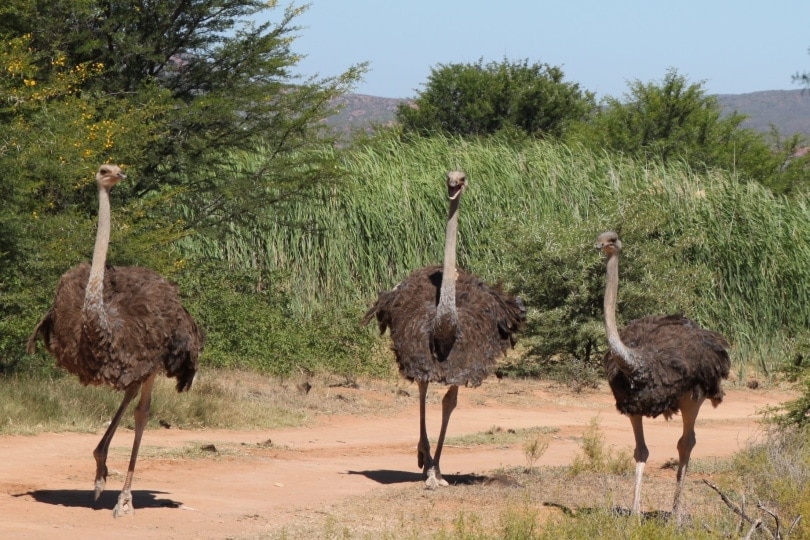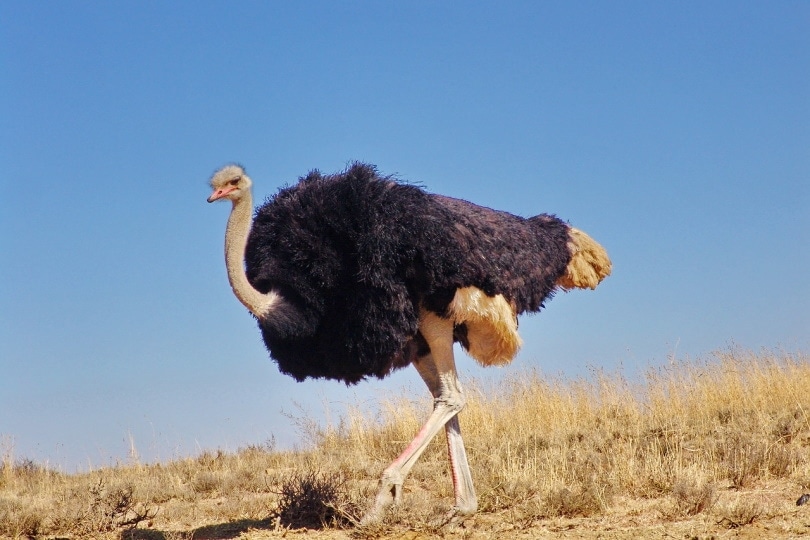What Does an Ostrich Sound Like? (With Videos)
Last Updated on

Ostriches can make a wide range of noises to communicate with each other. Common types of sounds that they make include chirping, honking, hissing, and grunting. Male ostriches can also make a special sound called “booming.”
Here’s everything you need to know about what an ostrich sounds like, along with the different ways they communicate with each other.

Common Sounds That Ostriches Make
Ostriches are social animals that live in flocks of less than 12 birds. A single, dominant male ostrich leads the herd, and the rest of the herd members are females. Ostriches stay in flocks for protection against predators and mating purposes.
Since ostriches are social, they have various ways of communicating with each other. One way that ostriches communicate is with vocal sounds. They’ll use certain types of sounds for specific reasons.

Louder sounds, such as honking and chirping, are used to gather attention. For example, baby ostriches can emit a high-pitched chirp as means of calling out to the rest of the flock. It’s a non-threatening sound that makes them easily identifiable and searchable for adult ostriches in its flock.
Ostriches can also screech to try to scare or intimidate other animals. They often accompany the screeching with raising their feathers to appear larger and more dangerous.
Ostriches will also hiss when they disapprove of something. It’s often a warning to start backing away and leave the ostrich alone. However, humans and other animals shouldn’t ever be close enough to an ostrich to hear it hissing.
An Ostrich’s Power
Ostriches are strong animals that can become very dangerous when provoked. These land birds can run over 40 miles per hour, so they have a very muscular and powerful set of legs. On top of that, they have extremely long and sharp claws.
A kick from an ostrich is often fatal for humans as ostriches can disembowel and kill a human with just one strike. Therefore, consider it a favor when an ostrich gives off a warning hiss. It’s best to leave ostriches alone and admire them from a distance because you’re better off not finding out what they can do when they feel threatened.

Ostrich Booming
Male ostriches are often fairly quiet, but they’re also capable of making one of the loudest sounds that ostriches can make. Booming is something that only male ostriches can do. Males will inflate their necks, keep their mouths closed, and use pressure to emit a low rumbling sound.
Sometimes, an ostrich can inflate his neck up to three times its normal size to produce this noise. It’s a loud sound that you can hear from a distance, and it’s also often mistaken for a lion’s roar.
Male ostriches boom as a mating technique. It’s a sound that they make to mark their territory, and they’ll boom to attract female ostriches during mating season.
Other Ways That Ostriches Communicate
Ostriches also communicate by using body language. For example, when an ostrich feels threatened and subordinate, it will lie down. Contrary to popular belief, ostriches don’t bury their heads in the sand when they’re afraid. They bow their heads as they lie down, so it only appears as though their heads are buried.
One of the most striking features of an ostrich is its beautiful, glossy feathers. So, it’s only natural that an ostrich will fluff up its feathers to display dominance and also use them in its mating ritual.

Ostriches’ Mating Ritual
One of the prime examples of body language is the ostrich’s elaborate mating dance. Ostriches’ mating season lasts from spring to fall. During this time, males will do their best to appear attractive to the dominant females in their flock because female ostriches can be very picky and selective.
While the male ostrich booms to attract the females’ attention, he’ll also strut around and ruffle up his feathers to appear more attractive. Sometimes, the female will run away and males will chase after them to show off their speed.
When all else fails, male ostriches will perform a mating dance to woo the females. He will get down to the ground and fan out his wings to display his impressive feathers. Then, he’ll tilt his neck back towards his body. Once everything is in position, he’ll start waving side to side.
Female ostriches that become attracted to this dance will then respond by flickering their feathers. This movement is a sign that the female is ready to mate. Rather than just walk over to the female, the male will delicately trot over to her to complete the mating dance.

Conclusion
Ostriches are social birds that use vocal sounds and body language to communicate with each other. They emit loud sounds, such as booming and chirping, when they’re seeking attention. They’ll hiss when they’re disturbed or ready to strike. Ostriches also use their feathers to send signals to each other.
Overall, ostriches are fascinating birds to observe. However, remember to always watch from a safe distance. These birds are strong, temperamental, and unpredictable. Fortunately, they’re the largest birds on land, and they’re hard to miss. So, you can enjoy watching them from afar and not miss out on any of the action.
Featured Image Credit: Piqsels
About the Author Robert Sparks
Robert’s obsession with all things optical started early in life, when his optician father would bring home prototypes for Robert to play with. Nowadays, Robert is dedicated to helping others find the right optics for their needs. His hobbies include astronomy, astrophysics, and model building. Originally from Newark, NJ, he resides in Santa Fe, New Mexico, where the nighttime skies are filled with glittering stars.
Related Articles:
10 Types of Hummingbirds in Arkansas (With Pictures)
8 Types of Hummingbirds in Nebraska (With Pictures)
5 Types of Hummingbirds in Idaho (With Pictures)
3 Types of Hummingbirds in Mississippi (With Pictures)
8 Types of Hummingbirds in Kansas (With Pictures)
5 Types of Hummingbirds in West Virginia (With Pictures)
5 Types of Hummingbirds in Ohio (With Pictures)
Where Do Nuthatches Nest? Nuthatch Nesting Habits Explained
